Mitsubishi Lancer Sportback 2010 Owner's Manual

Introduction
N09200100732
Thank you for buying a MITSUBISHI LANCER SPORTBACK.
We are confident you will enjoy your vehicle. It has been engineered for optimum performance, durability and comfort. By thoroughly reading this Owner’s Manual, you will gain an understanding of the many features that are included in the LANCER SPORTBACK. The Owner’s Manual contains descriptions and illustrations that will assist in the operation and maintenance of your vehicle.
Your Authorized Mitsubishi Motors Dealer will be happy to assist you with any further questions you may have regarding the operation of your vehicle.
Please note that this manual applies to all LANCER SPORTBACK models and explains all features including options. Some features explained in this manual may not be installed on your vehicle.
Please leave this Owner’s Manual in the vehicle at the time of resale. The next owner will appreciate having access to the information contained here.
This manual includes instructions for standard and optional equipment available at the time of printing. Mitsubishi Motors Corporation reserves the right to make changes in design and specifications and to make additions or improvements in its product without assuming any obligation to install these on previously manufactured products.
Throughout this manual the words WARNING and
CAUTION appear.
These are reminders to be especially careful. Failure to follow the instructions could result in personal injury or damage to your vehicle.
! WARNING
Indicates a strong possibility of severe personal injury or death if instructions are not followed.
! CAUTION
Points out hazards or unsafe practices that could cause minor personal injury or damage to your vehicle.
You will see another important symbol:
NOTE Gives helpful information.
! WARNING
●Engine exhaust, some of its constituents, and certain vehicle components contain or emit chemicals known to the State of California to cause cancer and birth defects and reproductive harm. In addition, certain fluids contained in vehicles and certain products of component wear contain or emit chemicals known to the State of California to cause cancer and birth defects or other reproductive harm.
©2009 Mitsubishi Motors Corporation |
Printed in Japan |

Table of contents
Overview 

 Quick index
Quick index 


General information 
 1
1
Seat and restraint systems 
 2
2
Features and controls 
 3
3
Driving safety 
 4
4
Comfort controls 
 5
5
For emergencies 
 6
6
Vehicle care and maintenance 
 7
7
Customer assistance/Reporting Safety Defects 
 8
8
Specifications 
 9
9
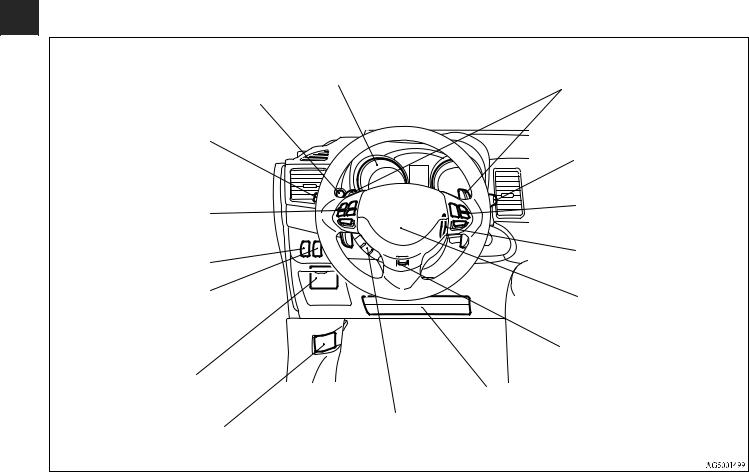
Overview
Instruments and controls (Driver’s area)
|
|
N00100201169 |
|
Except for RALLIART |
|
|
|
|
Instrument cluster P.3-160 |
Sportronic steering wheel paddle |
|
Multi-information meter switch P.3-168 |
shifter (if so equipped) P.3-100 |
||
|
|||
Combination headlights and |
|
Wiper and washer switch |
|
|
P.3-231 |
||
dimmer switch P.3-220 |
|
||
|
Rear window wiper and |
||
Turn signal lever P.3-228 |
|
||
|
washer switch P.3-238 |
||
Front fog light switch P.3-230 |
|
||
|
|
||
Steering wheel audio remote |
|
Cruise control switches |
|
control switches P.5-87 |
|
P.3-144 |
|
Headlight leveling switch |
|
Ignition switch |
|
|
P.3-24, 3-35, 3-81 |
||
(if so equipped) P.3-227 |
|
Supplemental restraint system |
|
Active stability control |
|
||
|
- airbag (for driver’s seat) |
||
(ASC) OFF switch P.3-141 |
|
P.2-36 |
|
|
|
Horn switch P.3-241 |
|
|
|
Steering wheel tilt lock |
|
Fuses P.7-48 |
|
lever P.3-76 |
|
|
Supplemental restraint system - driver’s |
||
|
|
||
|
|
knee airbag P.2-47 |
|
Engine hood release lever |
Hands-free Bluetooth®cellular phone interface system |
||
with voice recognition switches (if so equipped) P.3-242 |
|||
P.7-4 |
|||
|
|
||

|
|
|
Overview |
RALLIART |
|
|
|
Multi-information meter switch P.3-168 |
Instrument cluster P.3-160 |
Sportronic steering wheel paddle |
|
|
shifter P.3-118 |
||
|
|
|
|
Combination headlights and |
|
|
Wiper and washer switch |
dimmer switch P.3-220 |
|
|
P.3-231 |
Turn signal lever P.3-228 |
|
|
Rear window wiper and |
Front fog light switch P.3-230 |
|
|
washer switch P.3-238 |
Steering wheel audio remote |
|
|
Cruise control switches |
|
|
P.3-144 |
|
control switches P.5-87 |
|
|
|
|
|
|
|
|
|
|
Ignition switch |
Headlight leveling switch |
|
|
P.3-24, 3-35, 3-81 |
|
|
|
|
(if so equipped) P.3-227 |
|
|
Supplemental restraint system |
|
|
|
- airbag (for driver’s seat) |
Active stability control |
|
|
P.2-36 |
(ASC) OFF switch P.3-141 |
|
|
Horn switch P.3-241 |
|
|
|
Steering wheel tilt lock |
Fuses P.7-48 |
|
|
lever P.3-76 |
|
|
Supplemental restraint system - driver’s |
|
Engine hood release lever |
|
knee airbag P.2-47 |
|
Hands-free Bluetooth®cellular phone interface system |
|||
P.7-4 |
with voice recognition switches (if so equipped) P.3-242 |
||
|
|||

Overview
Instruments and controls
N00100201101
Except for RALLIART
|
|
Gearshift or selector lever P.3-90, 3-94 |
Supplemental restraint system - airbag |
||||||||
Vents P.5-2 |
(for front passenger’s seat) P.2-36 |
||||||||||
|
|
|
|
|
|
|
|
|
|
|
|
|
|
|
|
|
|
|
|
|
|
|
|
|
|
|
|
|
|
|
|
|
|
|
|
|
|
|
|
|
|
|
|
|
|
|
|
|
|
|
|
|
|
|
|
|
|
|
|
|
|
|
|
|
|
|
|
|
|
|
|
|
|
|
|
|
|
|
|
|
|
|
|
|
|
|
|
|
|
|
|
|
|
|
|
Parking brake lever |
|
P.3-74 |
Glove compartment P.3-285 |
|
Cup holder (for front seats) P.3-288 |
Fuel tank filler door |
|
release lever P.1-4 |
Heated seat switch (if so equipped) P.2-7 |
|
|
|
Floor console box P.3-287 |
12 V power outlet P.3-277 |
|

Overview
RALLIART
Vents P.5-2 |
Gearshift lever P.3-104 |
Supplemental restraint system - airbag |
||||||||
(for front passenger’s seat) P.2-36 |
||||||||||
|
|
|
|
|
|
|
|
|
|
|
|
|
|
|
|
|
|
|
|
|
|
|
|
|
|
|
|
|
|
|
|
|
|
|
|
|
|
|
|
|
|
|
|
|
|
|
|
|
|
|
|
|
|
|
|
|
|
|
|
|
|
|
|
|
|
|
|
|
|
|
|
|
|
|
|
|
|
|
|
|
|
|
|
|
|
|
|
Fuel tank filler door release lever P.1-4
Parking brake lever P.3-74
Cup holder  (for front seats)
(for front seats)  P.3-288
P.3-288 
Heated seat switch (if so equipped) P.2-7
12 V power outlet P.3-277 
Glove compartment P.3-285
ACD control mode switch P.3-128
Floor console box
P.3-287 Twin Clutch SST control mode switch P.3-113
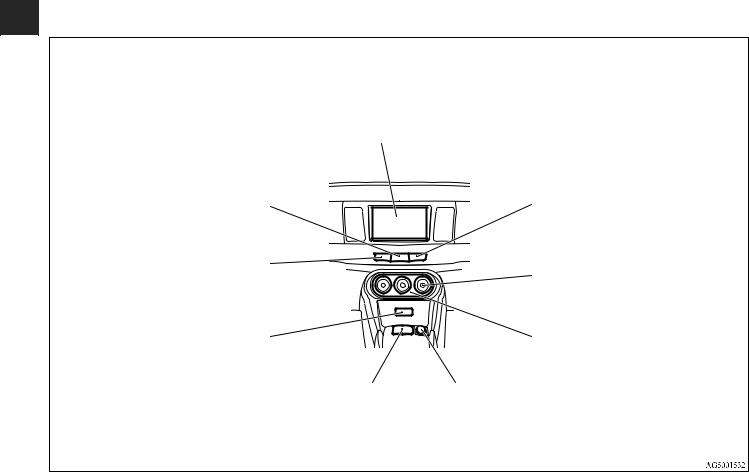
Overview
Center panel
N00100700112
<Type 1>
Audio (if so equipped) P.5-27, 5-55
Digital clock (if so equipped) P.5-99
Mitsubishi Multi-Communication System (if so equipped)
Refer to the separate “Mitsubishi Multi-Communication System owner’s manual”
Hazard warning flasher switch P.3-229
Passenger’s airbag off indicator P.2-45
Auxiliary Audio connector (RCA) (if so equipped) P.5-85
Auxiliary Video connector (RCA) (if so equipped) P.5-85
Front passenger seat belt warning light P.2-21
Electric rear window defogger |
switch P.3-240 |
Air conditioning
P.5-6, 5-16
Ashtray P.3-275 |
Cigarette lighter (if so equipped) P.3-276 |
|
12 V power outlet (if so equipped) P.3-277 |
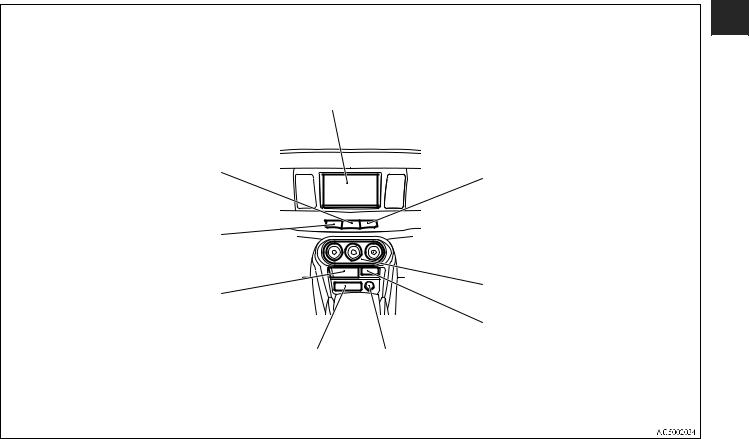
Overview
<Type 2>
Audio (if so equipped) P.5-27, 5-55
Digital clock (if so equipped) P.5-99
Mitsubishi Multi-Communication System (if so equipped)
Refer to the separate “Mitsubishi Multi-Communication System owner’s manual”
Hazard warning flasher switch P.3-229
Passenger’s airbag off indicator P.2-45
Front passenger seat belt warning light P.2-21
Electric rear window defogger switch  P.3-240
P.3-240
|
|
Air conditioning |
Front console box (Upper box) |
|
P.5-6, 5-16 |
P.3-286 |
|
Auxiliary Audio connector (RCA) |
|
|
(if so equipped) P.5-85 |
|
|
Auxiliary Video connector (RCA) |
Front console box (Lower box) |
12 V power outlet |
(if so equipped) P.5-85 |
P.3-286 |
P.3-277 |
|

Overview |
|
|
|
|
Interior |
|
|
|
|
|
N00100300929 |
|
Electric remote- |
|
Sunroof switch |
|
controlled outside |
Dome light (Front)/Reading lights |
(if so equipped) |
|
mirror switch |
P.3-279, 7-61, 7-88 |
P.3-71 |
Window lock switch |
P.3-79 |
|
|
P.3-70 |
|
|
|
Power window |
Power door lock |
|
|
switches P.3-66 |
|
|
|
|
switch P.3-56 |
Hands-free Bluetooth® cellular phone interface system |
|
|
|
||
|
|
with voice recognition microphone (if so equipped) |
|
|
|
P.3-242 |
|
Adjustable seat belt shoulder anchor (for front seats) P.2-21
Seat belts P.2-15
Rear shelf panel
P.3-290
Inside rearview mirror P.3-77
 Sun visors P.3-273
Sun visors P.3-273
Vanity mirror P.3-273
Card holder P.3-273
Bottle holder (for front seats)
P.3-289
Front seats P.2-3
Supplemental restraint system - side airbag (for front seats) P.2-53
Head restraints (except for RECARO seat) P.2-9

|
Overview |
Interior |
|
|
N00100300932 |
Supplemental restraint system - curtain airbag P.2-54 |
|
Coat hook P.3-293 |
Dome light (Rear) (if so equipped) |
Assist grips P.3-292 |
P.3-281, 7-61, 7-90 |
Luggage compartment |
|
levers P.2-14 |
|
Tether anchors for child restraint system P.2-30
Cargo floor boxes
(if so equipped) P.3-288
Dual height adjustable cargo floor board (if so equipped) P.3-291
 Rear seats P.2-8
Rear seats P.2-8
Cup holder (for rear seat) P.3-288
Arm rest P.2-8

Overview
Luggage compartment
N00100500396
|
Cargo room light |
Spare tire P.6-9 |
P.3-283, 7-61, 7-91 |
|
AWC control fluid reservoir (RALLIART) P.7-19
Tools P.6-7 |
Jack P.6-8 |
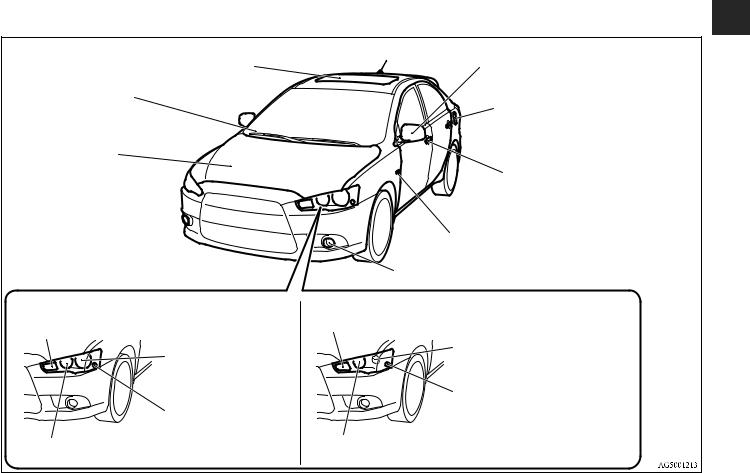
Overview
Outside (Front)
N00100601121
Except for RALLIART |
Sunroof (if so equipped) P.3-71 |
Outside rearview mirrors P.3-79 |
|
Windshield wiper P.3-231
Engine compartment
P.7-7
Engine hood P.7-4
[Except for vehicles with high intensity discharge headlights type]
Front turn signal lights P.3-228, 7-58, 7-73
Headlights, low beam P.3-220, 7-58, 7-61
Front side-marker and parking lights P.3-220, 7-58, 7-69
Headlights, high beam P.3-220, 7-58, 7-64
Fuel tank filler P.1-4
Locking and unlocking P.3-53 Keyless entry system
(if so equipped) P.3-8 F.A.S.T.-key (Free-hand Advanced Security Transmitter)
(if so equipped) P.3-16
Side turn signal lights P.3-228, 7-58
Front fog lights P.3-230, 7-58, 7-75
[For vehicles with high intensity discharge headlights type] Front turn signal lights P.3-228, 7-58, 7-73
Headlights, low/high beam P.3-220, 7-58, 7-68
Front side-marker and parking lights P.3-220, 7-58, 7-71
Daytime running lights P.3-220, 7-58, 7-66

Overview
RALLIART |
Sunroof (if so equipped) P.3-71 |
Outside rearview mirrors P.3-79 |
|
||
|
|
Windshield wiper P.3-231
Engine compartment
P.7-7
Engine hood P.7-4
[Except for vehicles with high intensity discharge headlights type]
Front turn signal lights P.3-228, 7-58, 7-73
Headlights, low beam P.3-220, 7-58, 7-61
Front side-marker and parking lights P.3-220, 7-58, 7-69
Headlights, high beam P.3-220, 7-58, 7-64
Fuel tank filler P.1-4
Locking and unlocking P.3-53 Keyless entry system
(if so equipped) P.3-8 F.A.S.T.-key (Free-hand Advanced Security Transmitter)
(if so equipped) P.3-16
Side turn signal lights P.3-228, 7-58
Front fog lights P.3-230, 7-58, 7-78
[For vehicles with high intensity discharge headlights type]
Front turn signal lights
P.3-228, 7-58, 7-73 Headlights, low/high beam P.3-220, 7-58, 7-68
Front side-marker and parking lights P.3-220, 7-58, 7-71
Daytime running lights P.3-220, 7-58, 7-66

Overview
Outside (Rear)
N00100601017
Rear window wiper P.3-238
High-mounted stop light
P.7-58
Rear hatch P.3-59
Antenna P.5-97
Tire inflation pressure P.7-33 Changing tires P.6-8
Tire rotation P.7-36 Tire chains P.7-38
Tire pressure monitoring system P.3-153
Rear side-marker lights
P.3-220, 7-58, 7-82
|
Rear turn signal lights |
License plate lights P.3-220, 7-58, 7-86 |
P.3-228, 7-58, 7-82 |
Back-up lights P.7-58, 7-84 |
Tail and stop lights P.3-220, 7-58, 7-82 |
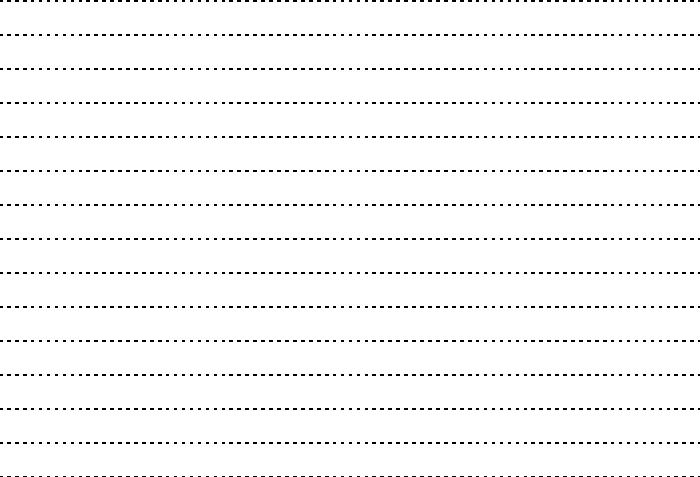

Quick index
If this warning light comes on or flashes while you’re driving...
N00200701019
NOTE
●For information regarding warning displays in the multi-information display, refer to “Multi-information display indicators” on page 3-164.
●These warning lights will come on for a few seconds for a bulb check when the ignition switch is first turned to “ON”.
Warning light |
Do this |
Ref. page |
||||||
|
|
|
|
|
|
|
|
|
|
|
|
|
|
|
|
● Park your vehicle in a safe place and stop the engine. |
|
|
|
|
|
|
|
|
|
|
|
|
|
|
|
|
|
|
|
|
|
|
|
|
|
|
Contact an authorized Mitsubishi Motors dealer or a repair facility of |
P.3-216 |
|
|
|
|
|
|
|
your choice for assistance. |
|
Charging system warning light |
|
|||||||
|
|
|||||||
|
|
|
|
|
|
|
|
|
|
|
|
|
|
|
|
● If this light comes on while driving, check to see that the parking |
|
|
|
|
|
|
|
|
brake is fully released. |
|
|
|
|
|
or |
● If this light stays on after releasing the parking brake, stop and check |
|
||
|
|
|
|
the brake fluid level. |
P.3-214 |
|||
|
|
|
|
|
|
|
||
|
|
|
|
|
|
|
● If the brake fluid level is correct, there may be a system malfunction. |
|
Brake warning light |
Avoid hard braking and high speeds, and contact an authorized Mit- |
|
||||||
subishi Motors dealer or a repair facility of your choice for assistance. |
|
|||||||
|
|
|
|
|
|
|
|
|
|
|
|
|
|
|
|
|
|
|
|
|
|
|
|
|
● Although your vehicle will usually be drivable and not need towing, |
|
|
|
|
|
or |
have the engine system checked at an authorized Mitsubishi Motors |
|
||
|
|
|
|
|
||||
|
|
|
|
|
||||
|
|
|
|
dealer or a repair facility of your choice as soon as possible. If the |
|
|||
|
|
|
|
|
|
|
|
|
|
|
|
|
|
|
|
vehicle is not drivable, contact emergency roadside assistance at 1- |
P.3-215 |
Engine malfunction indicator |
888-648-7820 (for vehicles sold in U.S.A.) or 1-888-576-4878 (for |
|
||||||
vehicles sold in Canada), an authorized Mitsubishi Motors dealer, or |
|
|||||||
(“SERVICE ENGINE SOON” or “Check |
|
|||||||
local towing company for assistance. |
|
|||||||
|
engine light”) |
|
||||||
|
|
|
||||||
|
|
|
|
|
|
|
|
|
1
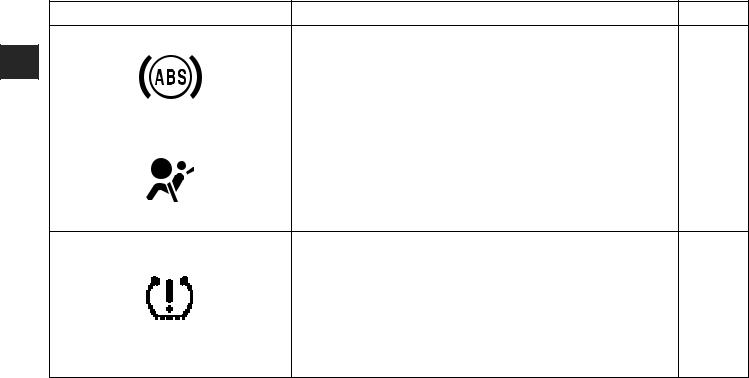
Quick index
Warning light |
Do this |
Ref. page |
|
|
|
●When this light comes on, the anti-lock braking system is not functioning and only the ordinary braking system is functioning.
●Park your vehicle in a safe place and stop the engine.
|
Test the system as described on page 3-137. |
P.3-136, |
|
● If the light does not go out after the test, or if it comes on again, we |
3-137 |
Anti-lock braking system warning light |
recommend that you have the system checked at an authorized Mit- |
|
subishi Motors dealer or a repair facility of your choice as soon as |
|
|
|
possible. |
|
|
|
|
|
● It is not necessary to stop the vehicle immediately, but we recommend |
P.2-24, |
|
that you have the airbag and the pre-tensioner seat belt system |
|
|
checked at an authorized Mitsubishi Motors dealer as soon as possi- |
2-46 |
SRS warning light |
ble. |
|
|
|
|
● If the warning light comes on, you should stop and adjust the tires to |
|
|
the proper inflation pressure as soon as possible. |
|
|
(See “Tire inflation pressures” on page 7-33.) |
|
|
Once adjustments have been made, the warning light will go off after |
|
|
a few minutes of driving. |
P.3-154 |
|
● If the warning light blinks for approximately 1 minute and then |
|
|
|
|
Tire pressure monitoring system warning light |
remains continuously illuminated, the system is not operating prop- |
|
erly. If the system returns to normal, the warning light will go off. If |
|
|
|
the warning light does not go off, have the vehicle inspected at an |
|
|
authorized Mitsubishi Motors dealer. |
|
2

|
|
Quick index |
|
|
|
If this problem occurs... |
|
|
|
|
|
N00200900740 |
|
|
|
|
|
|
|
Problem |
Do this |
Ref. Page |
|
|
|
||||
|
|
|
|
|
Cannot turn the key. |
When using a key to start the engine |
|
|
|
(When using a key to start the |
Will not turn from “LOCK” to “ACC”. |
|
|
|
engine) |
Turn the key while turning the steering wheel in either direction. |
|
|
|
Will not turn from “ACC” to “LOCK”.
|
|
|
|
|
Vehicles equipped with continuously variable transmission (CVT) or Twin Clutch |
P.3-82, |
|
|
|
|
|
SST: |
3-84 |
|
|
|
|
|
Check the position of the selector lever (CVT) or the gearshift lever (Twin Clutch SST). |
|
|
|
|
|
|
The key cannot be removed unless the selector lever (CVT) or the gearshift lever (Twin |
|
|
|
|
|
|
Clutch SST) is set to the “P” (PARK) position. |
|
|
|
|
|
|
Vehicles equipped with manual transaxle: |
|
|
|
|
|
|
Place the key at the “ACC” position. Push the key in and turn it. |
|
(When using the F.A.S.T.-key |
When using the F.A.S.T.-key to start the engine |
|
||||
|
||||||
Will not turn from “LOCK (PUSH OFF)” to “ACC”. |
|
|||||
to start the engine) |
|
|||||
|
|
|
|
|
Push the ignition switch again, turn the steering wheel in both directions and then turn the |
|
|
|
|
|
|
ignition switch. |
|
|
|
|
|
|
Will not turn from “ACC” to “LOCK”. |
P.3-16 |
|
|
|
|
|
Vehicles equipped with CVT or Twin Clutch SST: |
|
|
|
|
|
|
Check whether the selector lever (CVT) or the gearshift lever (Twin Clutch SST) is set to |
|
|
|
|
|
|
the “P” (PARK) position. |
|
|
|
|
|
|
Vehicles equipped with manual transaxle: |
|
|
|
|
|
|
Place the ignition switch at the “ACC” position. Push the ignition switch in and turn it. |
|
|
|
|
|
|
|
|
The F.A.S.T.-key does not |
|
|
||||
operate. |
Use the emergency key to lock and unlock the doors and start the engine. |
P.3-34 |
||||
(for vehicles equipped with the |
||||||
F.A.S.T.-key) |
|
|
||||
3

Quick index
|
|
Problem |
|
Do this |
|
Ref. Page |
|
|
Cannot shift the selector lever |
|
|
|
|
|
|
(CVT) or the gearshift lever |
Shift the selector lever (CVT) or the gearshift lever (Twin Clutch SST) while pressing the |
|
||
|
|
|||||
|
|
(Twin Clutch SST) from the |
|
|||
|
|
brake pedal. |
|
|
P.3-94, 3-104 |
|
|
|
“P” (PARK) position. |
|
|
||
|
|
Check that the ignition key or ignition switch is in the “ON” position. |
|
|||
|
|
(for vehicles equipped with |
|
|||
|
|
|
|
|
|
|
|
|
CVT or Twin Clutch SST) |
|
|
|
|
|
|
|
|
|
|
|
|
|
The windows are fogged up. |
|
|
|
|
|
|
|
1. Set the mode selection dial to the “ |
” or “ |
” position. |
P.5-14, 5-24 |
|
|
|
2. Turn on the blower. |
|
|
|
|
|
|
|
|
|
|
The engine does not start. |
|
|
|
The lights do not come on. |
|
P.6-2, |
|
The lights are dim. |
Have the battery checked. Recharge or replace as needed. |
||
7-23 |
|||
The horn does not honk. |
|
||
|
|
||
The horn sound is weak. |
|
|
4

Quick index
Problem |
Do this |
The engine coolant tempera-
ture display “ ” in the multiinformation display is flashing. Steam comes out of the engine compartment.
Type 1
The engine is overheated.
Carefully stop the vehicle in a safe place.
Type 2
The vehicle is stuck in sand, |
Rock your vehicle back and forth to free it. |
|
mud, or snow. |
||
|
! WARNING
Ref. page
P.6-5
P.6-20
●When attempting to rock your vehicle out of a stuck position, be sure that no one is near the vehicle. The rocking motion may cause the vehicle to suddenly lurch forward or backward, possibly injuring bystanders.
●Avoid revving the engine or spinning the wheels. Prolonged efforts to free a stuck vehicle may result in overheating and transaxle failure.
If the vehicle remains stuck after several rocking attempts, have a towing service pull the vehicle out.
5

Quick index
|
|
Problem |
Do this |
Ref. page |
|
|
|
|
|
|
|
The brakes are not functioning |
|
|
|
|
properly after driving through |
Dry out the brakes by driving slowly while lightly pressing the brake pedal. |
P.4-6 |
|
||||
|
|
water. |
|
|
|
|
|
|
|
|
|
The CVT makes no engine |
|
|
|
|
speed to vehicle speed ratio |
There may be a problem in the CVT. |
|
|
|
change when accelerating. The |
|
|
|
|
initial movement of the vehicle |
If the or warning lights on the multi-information display will not turn off, or if they |
P.3-103 |
|
|
is slow when the vehicle starts |
are coming on frequently, please have the vehicle checked at your nearest Mitsubishi |
|
|
|
|
||
|
|
moving. |
Motors dealer. |
|
|
|
(for vehicles equipped with |
|
|
|
|
CVT) |
|
|
|
|
|
|
|
|
|
Twin Clutch SST does not |
|
|
|
|
shift. |
|
|
|
|
Vehicle cannot move. |
|
|
|
|
Acceleration is slow. |
|
|
|
|
The vehicle does not creep. |
The temperature of the Twin Clutch SST fluid is high, a safety device in the Twin Clutch |
P.3-109, |
|
|
A large shock is felt when |
||
|
|
SST has been activated due to a possible malfunction in the Twin Clutch SST, or there is |
3-123, |
|
|
|
shifting. |
||
|
|
a possible malfunction in the engine electronic control module. |
3-215 |
|
|
|
Shifting occurs at higher |
||
|
|
|
|
|
|
|
engine speed. |
|
|
|
|
Response is slow. |
|
|
|
|
(for vehicles equipped with |
|
|
|
|
Twin Clutch SST) |
|
|
|
|
|
|
|
6

|
|
|
Quick index |
|
|
|
|
|
|
|
|
Problem |
|
Do this |
Ref. page |
|
|
|
|
|
|
|
|
A tire is punctured. |
|
|
|
|
|
|
1. |
Park the vehicle in a safe place where the surface is flat and level. |
P.6-8 |
|
|
|
|
|
|||
|
|
||||
|
2. |
Replace the flat tire with the spare tire. |
|
|
|
|
|
|
|
||
|
|
|
|
|
|
7

General information
Fuel selection |
1- |
2 |
|
|
|
|
|
|
|
||||
Filling the fuel tank . . . . . . . . . . . . . . . . . . . . . . . . |
1- |
4 |
|
|
|
|
1 |
||||||
Modification of your vehicle . . . . . . . . . . . . . . . . . |
1- |
7 |
|
|
||
Mitsubishi Motors genuine parts . . . . . . . . . . . . . . |
1- |
9 |
|
|
|
|
|
||||||
California Perchlorate Materials Requirements. . . |
1- |
10 |
|
|
|
|
|
|
|
|
|
|
|
|
|
|
|
|
|

General information
Fuel selection
N00301000765
Your vehicle is designed to use unleaded gasoline only. It is equipped with a fuel filler tube especially designed to accept only a small diameter unleaded gasoline dispensing nozzle.
|
|
! |
WARNING |
1 |
|
||
|
|
|
|
|
|
● Gasoline is highly flammable and explosive. You |
|
|
|
|
could be burned, seriously injured or killed when |
|
|
|
handling it. Whenever you refuel your vehicle, stop |
|
|
|
the engine and keep flames, sparks, and smoking |
|
|
|
materials away from the vehicle. Always handle fuel |
|
|
|
in well-ventilated outdoor areas. |
! CAUTION
●Using leaded gasoline in your vehicle will damage the engine, catalytic converter, and the oxygen sensors. Also, using leaded gasoline is illegal, and will void your warranty coverage of the engine, catalytic converter, and oxygen sensors.
Gasoline detergent additives
In the United States, fuel suppliers are required by law to add detergents to their gasoline to minimize fuel-injector fouling and minimize intake-valve deposits. Detergent gasoline helps keep your engine in tune and your emission-control system working properly.
Octane requirement
Except for vehicles equipped with turbocharger
Your vehicle is designed to operate on unleaded gasoline having a minimum octane number of 87 [(MON+RON)/2], or 91 RON.
Vehicles equipped with turbocharger
Your vehicle is designed to operate on premium grade unleaded gasoline having a minimum octane rating of 93 [(MON+RON)/2] or higher for optimum performance. In case premium grade unleaded gasoline 93 [(MON+RON)/2] is not available, unleaded gasoline rating of 91 [(MON+RON)/2] can be used. However, the performance level is reduced.
In order to maintain exhaust system durability, premium unleaded gasoline having an octane rating of at least 91 [(MON+RON)/2] must be used.
If the premium grade unleaded gasoline rating of 91 [(MON+RON)/2] or higher is not available on journey, etc., regular unleaded gasoline having an octane rating of 87 [(MON+RON)/2] can be used temporarily as an emergency measure.
MON: Motor Octane Number
RON: Research Octane Number
1-2

Oxygenated gasoline
Gasoline sold at some service stations contains oxygenates such as ethanol and MTBE, although the oxygenates may not be identified by those names. Oxygenates are required in some areas of the country. Such fuel can be used in your vehicle.
Ethanol (Gasohol)
A mixture of up to 10 % ethanol (grain alcohol) and 90 % unleaded gasoline may be used in your vehicle, provided the octane number is at least as high as that recommended for unleaded gasoline.
Methanol
Do not operate your vehicle on gasoline containing methanol (wood alcohol). Using this type of alcohol could adversely affect the vehicle’s performance and damage critical parts of the vehicle’s fuel system.
Reformulated gasoline
Many areas of the country require the use of cleaner burning fuel referred to as “Reformulated Gasoline”.
Reformulated gasoline contains oxygenates and is specially blended to reduce vehicle emissions and improve air quality. Mitsubishi Motors Corporation strongly supports the use of reformulated gasoline. Properly blended reformulated gasoline has no adverse effect on vehicle performance or the durability of the engine and fuel system.
General information
MMT (methylcyclopentadienyl manganese tricarbonyl)
MMT is a manganese-containing metallic additive that is blended into some gasolines to increase the octane number. Mitsubishi Motors Corporation recommends using gasolines without MMT.
Use of gasolines blended with MMT may adversely affect per- 1 formance, and cause the malfunction indicator on your instrument panel to come on. If this happens, contact an authorized Mitsubishi Motors dealer or a repair facility of your choice for assistance.
Sulfur in gasoline
Your vehicle may have been designed to satisfy California’s low-emission regulations based on clean-burning low-sulfur gasoline. Gasoline sold in parts of the country other than California is allowed to have a higher sulfur content. Using such gasoline could adversely affect the vehicle’s catalytic converter and cause the engine malfunction indicator (“SERVICE ENGINE SOON” or “Check engine light”) to come on. Illumination of this indicator while you are using high-sulfur gasoline does not necessarily mean the vehicle’s emission-control system is malfunctioning. Your authorized Mitsubishi Motors dealer may suggest you try using a different, lower-sulfur brand of unleaded gasoline to determine whether the problem is fuel-related.
1-3

General information
NOTE
●Poor-quality gasoline can cause problems such as poor starting, stalling during idling, abnormal engine noise, and poor acceleration. If you experience any of these problems, try using a different brand of gasoline. If the engine malfunction indicator (“SERVICE ENGINE SOON” or “Check engine light”) flashes, have the vehicle inspected
1as soon as possible by the nearest authorized Mitsubishi Motors dealer or a repair facility of your choice.
●Repeatedly driving short distances at low speeds can cause deposits to form in the fuel system and engine, resulting in poor starting and poor acceleration. If these problems occur, you are advised to add a detergent additive to the gasoline when you refuel the vehicle. The additive will remove the deposits, thereby returning the engine to a normal condition. Be sure to use a genuine Mitsubishi cleaning additive. Using an unsuitable additive could make the engine malfunction. For details, please contact the nearest authorized Mitsubishi Motors dealer.
Filling the fuel tank
N00301100841
! WARNING
●Gasoline is highly flammable and explosive. You could be burned, seriously injured or killed when handling it. When refueling your vehicle, always turn the engine off and keep away from flames, sparks, and smoking materials. Always handle fuel in well-ventilated outdoor areas.
●Before removing the fuel cap, be sure to get rid of your body’s static electricity by touching a metal part of the car or fuel pump. Any static electricity on your body could create a spark that ignites fuel vapor.
●Perform the whole refueling process (opening the fuel tank filler door, removing the fuel cap, etc.) by yourself. Do not let any other person come near the fuel tank filler. If you allowed a person to help you and that person was carrying static electricity, fuel vapor could be ignited.
●Do not move away from the fuel tank filler until refueling is finished. If you moved away and did something else (for example, sitting on a seat) partway through the refueling process, you could pick up a fresh charge of static electricity.
●Be careful not to inhale fuel vapor. Fuel contains toxic substances.
●Keep the doors and windows closed while refueling the vehicle. If they were open, fuel vapor could get into the cabin.
1-4
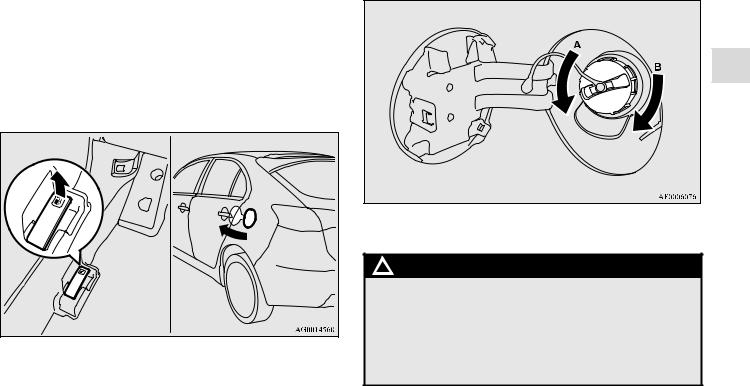
Fuel tank capacity
2WD: 15.5 gal (59 liters) 4WD: 14.5 gal (55 liters)
Refueling
1.Before filling with fuel, stop the engine.
2.The fuel tank filler is located on the rear driver side of your vehicle.
The fuel tank filler door can be opened from inside the vehicle with the fuel tank filler door release lever located at the left side of the driver’s seat.
General information
3.Open the fuel tank filler pipe by slowly turning the cap counterclockwise.
1
A- Remove
B- Close
! WARNING
●Since the fuel system may be under pressure, remove the fuel tank filler cap slowly. This relieves any pressure or vacuum that might have built up in the fuel tank. If the cap is venting vapor or if you hear a hissing sound, wait until it stops before removing the cap. Otherwise, fuel may spray out, injuring you or others.
1-5

General information
4.While filling with fuel, store the cap in the cap holder located on the inside of the fuel tank filler door.
1
5.To fill with fuel correctly depends mainly on correct handling of the fuel filler nozzle. Do not tilt the nozzle. Insert the nozzle in the tank port as far as it will go.
! CAUTION
●Your vehicle can only be operated using unleaded gasoline. Serious engine and catalytic converter damage will result if leaded gasoline is used.
6.When the nozzle stops automatically, do not attempt to add more fuel.
! CAUTION
●To avoid fuel spillage and overfilling, do not “topoff” the fuel tank. Spilled fuel could discolor, stain, or crack the vehicle’s paintwork. If fuel spills on the paintwork, wipe it off with a soft cloth.
7.To close, turn the fuel tank filler cap slowly clockwise until you hear clicking sounds, then gently push the fuel tank filler door closed.
! WARNING
●Make sure the fuel cap is securely closed. If the fuel cap is loose, fuel could leak, resulting in a fire.
! CAUTION
●If you need to replace the fuel tank filler cap, use only the cap specified for your model vehicle.
1-6
NOTE
●If the fuel tank filler cap is not tight while driving, the engine malfunction indicator (“SERVICE ENGINE SOON” or “Check engine light”) may come on when the onboard diagnostic (OBD) system performs a self check. Always tighten the fuel tank filler cap until you hear clicking sounds.
The indicator will go off after driving several times. If the indicator does not go off, contact your authorized Mitsubishi Motors dealer or a repair facility of your choice as soon as possible.
General information
Modification of your vehicle
N00301600048 |
|
This vehicle should not be modified with non-Mitsubishi |
|
Motors genuine parts. Modification with non-Mitsubishi |
|
Motors genuine parts could affect its performance, safety or |
|
durability, and may even violate regulations. In addition, dam- |
|
age or performance problems resulting from the modification |
1 |
may not be covered under warranty. |
|
|
|
1-7
